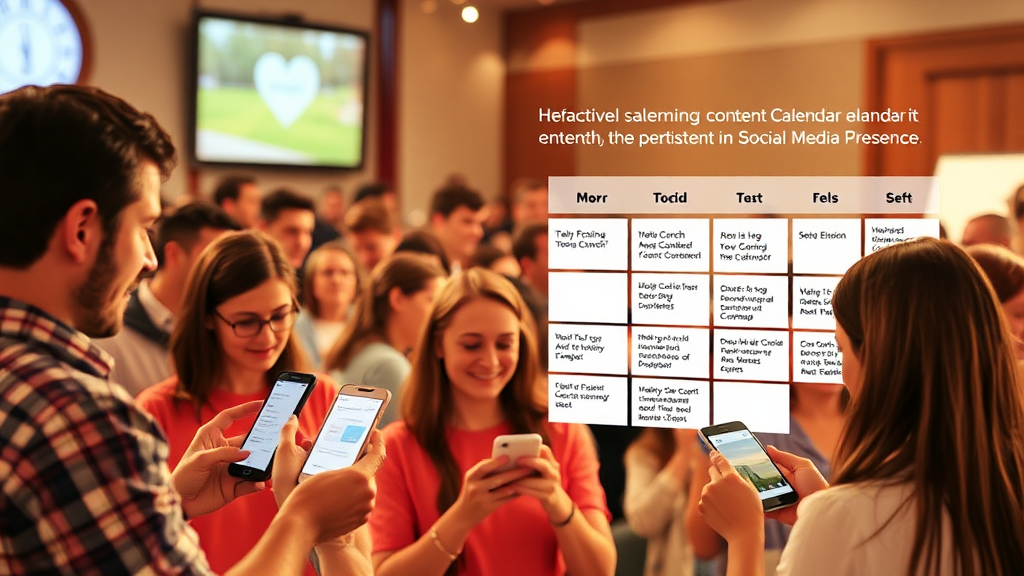Creating engaging content for your church’s website is crucial to fostering community interaction, outreach, and a welcoming atmosphere for both existing members and potential newcomers. In a digital age where social media serves as a vital communication platform, producing high-quality, relatable content can significantly enhance your church’s online presence.
Key Takeaways
- Importance of Content: Engaging content builds community and reflects the church's values, fostering deeper connections.
- Repurposing Resources: Utilize existing materials like sermons, bulletins, and member stories to generate fresh content.
- Multimedia Engagement: Incorporating videos, visuals, and interactive elements enhances content appeal and memory retention.
- Understanding Your Audience: Tailoring content to meet the diverse preferences of your congregation is essential for engagement.
- Best Practices for Website: Implement clear navigation, dynamic content sections, and real stories to encourage visitor interaction.
Looking for help with your church's digital presence? Contact ipsom.io for expert assistance!
Importance of Engaging Content for Church Websites
Creating engaging content for your church's website plays a vital role in building a strong community and attracting newcomers. Key points regarding the significance of engaging content include:
- Reflects Church Values: High-quality content communicates the church's mission and fosters deeper connections among members.
- Powerful Outreach Tool: Engaging content enhances communication within the church community and serves as a vital outreach mechanism.
- Essential Online Presence: In today's digital age, having an engaging online presence is critical for community-building.
The Role of Social Media
Effective use of social media can significantly boost your church's visibility. Here’s how:
- Unique Marketing Opportunities: Promote events and share the church's cultural aspects through engaging posts.
- Dedicated Staff for Management: Having staff responsible for social media management ensures regular and impactful content delivery.
- Content Repurposing: Repurpose sermons or community event content to maintain an active social media presence with minimal additional resources.
Engaging Members Through Content
Transforming sermon content into various formats can maximize engagement. Consider the following strategies:
- Multi-Platform Uploads:
- Upload sermon videos to YouTube
- Share snippets on Instagram
- Create inspiring quote graphics for social media
- Catering to Preferences: This approach broadens your reach and accommodates different audience preferences.
- Weekly Announcements: Adapting announcements into engaging digital content helps keep the congregation informed and connected throughout the week.
By utilizing these methods, your church can create a vibrant online community that complements in-person gatherings and enhances spiritual growth. For further strategies on effective content utilization, explore our article on SEO for Small Businesses.
Best Practices to Drive Engagement
Creating a welcoming and interactive online environment is essential for church websites. Authentic storytelling plays a pivotal role in this engagement. Highlighting real experiences through diverse member testimonials illustrates the profound impact of faith on individual lives. Combining written stories with multimedia elements such as photos or videos enhances engagement, making the narratives more relatable and compelling.
Engaging content should extend beyond Sunday services. Incorporating interactive components like discussion boards and live prayer sessions fosters a sense of community and encourages participation. Training leaders effectively ensures they can facilitate these online discussions and makes the congregation feel more connected, even in a digital landscape.
Providing resource-rich sermons is another best practice. Uploading audio or video recordings along with comprehensive support materials, such as study guides and moderated comment sections, allows congregants to engage with the content meaningfully. These resources help deepen understanding and promote further exploration of the topics discussed.
Creating a seamless visitor experience is vital. Sections addressing common questions about the church can guide newcomers and make them feel welcomed. Implementing clear calls-to-action encourages visitors to engage further, whether that means signing up for newsletters, joining community groups, or attending events.
Content Creation Strategies
Creating effective content for your church's website requires a solid understanding of your audience. Implementing strategic content creation involves several key components:
-
Audience Analysis:
- Understand audience demographics such as age, interests, and preferred content types.
- Tailor engagement efforts based on who your congregation is.
- Example:
- Younger congregants prefer dynamic, visually appealing content on Instagram.
- Older members may engage more on Facebook with text-based updates.
-
Visual Appeal:
- High-quality visuals greatly enhance your website and social media presence.
- Use images that reflect your church’s mission and community.
- Consider using tools like Canva to create professional-grade graphics.
- Ensure visuals stand out while maintaining brand consistency.
-
Engaging Content:
-
Combine compelling imagery and insightful messages to attract and retain visitors.
-
Diverse Content Formats:
- Integrate various content types to cater to different preferences, such as:
- Blogs
- Podcasts
- Videos
- A multi-format approach helps connect with different segments of your congregation.
- Integrate various content types to cater to different preferences, such as:
-
Platform-Specific Strategies:
- Tailor your content strategy according to the platforms preferred by your audience.
- This leads to more effective engagement and a thriving online community.
By focusing on these strategies, you'll create relevant content that resonates with your congregation and enhances your church's digital presence.
Interactive and Engaging Content
Creating interactive and engaging content is essential for fostering a vibrant online community for your church. Incorporating elements like polls, quizzes, and surveys encourages participation and gives members a voice. This not only enhances engagement but also allows you to gather valuable feedback to improve future content and activities.
Enhancing Engagement
Using a well-planned hashtag strategy can significantly enhance your church's visibility on social media platforms. Hashtags related to your events, sermons, or community activities can help reach a wider audience and attract potential newcomers. Engaging content encourages organic interaction, transforming passive viewers into active participants in your church's mission.
Frequency and Consistency
Regular content updates are vital to maintaining audience interest and relevance. A consistent voice and aesthetic across all platforms strengthen your church's brand identity. Aim for a content calendar that allows for frequent posts while adhering to your church's messaging and values. This not only keeps your current congregation engaged but also makes your church appealing to newcomers exploring your online presence.
Core Must-Haves for Every Church Website
A well-structured church website is key to enhancing community engagement and outreach. Each element plays a vital role in how visitors perceive and interact with the church online. Here are the core must-haves that every church website should include to ensure an effective digital presence.
Essential Website Elements
-
General Information:
- Clearly present the church history, mission, and values.
- Ensure visitors can easily understand what the church stands for and its role in the community.
-
Contact Information:
- Provide easy access to communication channels.
- Include an email address, phone number, and links to social media platforms to facilitate reaching out with questions.
-
Authentic Imagery:
-
Use high-quality, real-life photos that showcase your congregation's life and activities.
-
Authentic imagery fosters trust and connection with potential newcomers.
-
Visibility of Links:
- Make important links, such as streaming services and donation buttons, easily accessible.
- Ensure these elements are prominent to facilitate engagement and support.
-
Timely Updates:
- Regularly refresh content with news and events to keep members informed.
- Fresh updates demonstrate an active community and encourage visitors to engage regularly.
-
Service Schedules:
-
Clearly outline service times and locations.
-
Make this information easy to find to help newcomers attend without confusion.
- Event Promotion:
- Highlight upcoming events prominently on the homepage.
- Engaging events encourage community participation and help members stay connected.
By incorporating these essential elements, your church website can become a powerful tool for outreach, connection, and community building.
Additional Considerations
- Consult with Experts:
- Consider working with web design professionals to create a site that truly reflects your church’s mission and meets the needs of your congregation.
Implementing these must-haves will ensure your church website effectively serves its purpose and enhances its digital presence.
Overall Importance of a Church Website
-
Vital Outreach Tool: A church website is essential in today’s digital environment.
-
Amplifies Community Reach:
- Provides essential information and resources for existing members and newcomers.
- Attracts and engages individuals seeking community and spiritual guidance.
-
Significant Online Presence:
- Over 4.57 billion active internet users worldwide necessitate a strong online presence.
Importance of Mobile-Friendliness
-
Mobile-Friendly Design:
- Recent studies indicate that over 50% of web traffic comes from mobile devices.
- A responsive design improves navigation on any device.
-
Enhanced User Experience:
- Easy access to vital information fosters a sense of community.
- Reflects the welcoming values of the church.
Driving Engagement and Connection
-
Encourages Participation:
- A well-structured site motivates visitors to engage in church activities.
- Keeps visitors informed about upcoming events and church missions.
-
Welcoming Environment:
- Promotes dialogue and community growth.
- Mirrors the core values and teachings of the church, creating a space for connection and interaction.
FAQ
What type of content should we create for our church website?
Creating engaging content for your church website is essential. Focus on sermon summaries, member testimonials, and informative articles that reflect your church's values. Additionally, consider incorporating event promotions and community outreach initiatives. Always aim for diversity in content types, such as written articles, videos, and podcasts, to cater to different audience preferences.
How can we repurpose sermon materials for social media?
To maximize your sermon materials, transform them into various formats for social media. Consider short video clips of impactful sermon moments for platforms like YouTube or Instagram. Create engaging quote graphics from sermon points to share on Facebook or Twitter. Moreover, write summaries or reflections for blog posts, linking back to the full sermon for those interested in deeper exploration.
What are some effective ways to engage our community online?
Engaging your community online requires a mix of strategies. Use interactive polls and surveys to gather feedback and encourage participation. Regularly update your website with event highlights and real-life stories from members. Create discussion forums or live prayer sessions that foster community connections, showing that your church is active and involved in members' lives.
How should we handle social media management?
Social media management is best approached with a clear strategy. Designate a dedicated team member to oversee content creation and engagement. Regularly schedule posts to keep your audience informed. Ensure interactions are genuine and timely. Consider using management tools like Hootsuite to streamline your posting schedules and monitor discussions across various platforms.
What tools can simplify visual content creation?
High-quality visuals are crucial for engagement. Use tools like Canva, which offers user-friendly templates to create graphics, posters, and posts easily. Another option is Adobe Spark for video content creation. Ensure you have access to a stock photo library or take original photos that reflect your church community to maintain authenticity in your visual content.
How do we ensure our website meets the needs of newcomers?
To serve newcomers effectively, it's vital to include specific sections on your website addressing FAQs, service schedules, and how to get involved. Create a dedicated newcomer’s guide that outlines what to expect on their first visit. Additionally, include virtual tours and easy access to contact information to help address any questions they might have.
What interactive elements can we include on our site for engagement?
Incorporate various interactive elements to enhance engagement on your site. Consider adding discussion boards, live chat options, or event sign-up forms. Polls and quizzes related to church teachings or community feedback help gather input. Create a prayer request section where members can submit and share their needs in a supportive environment.
How important is it to understand our audience demographics for content creation?
Understanding your audience demographics is crucial for creating relevant content. Analyze data such as age, interests, and preferred platforms to deliver tailored messages. Adjust your content style according to what resonates best with different segments within your congregation. This targeted approach enhances engagement and fosters a deeper sense of community.
Why is storytelling critical for our church’s messaging?
Storytelling is vital because it connects emotionally with your audience. Sharing real-life experiences and testimonials illustrates the impact of faith on your congregation's lives. By utilizing vibrant narratives, you can effectively convey your church's core values and mission, making the content relatable and inspiring for both current members and newcomers.
How frequently should we update our church website content?
Regular updates are essential to maintain interest and relevance. Aim to refresh your church website content at least weekly or bi-weekly. Frequent updates can include new sermon summaries, upcoming event information, or member stories. Consistent content updates not only improve visitor retention but also enhance your church’s visibility on search engines.





